Trying to trace Christopher Wheeldon’s career, you might decide he has a vagabond streak that tugs against a now-and-then yen for stability. As a young dancer and choreographer-in-waiting, he left Britain’s Royal Ballet for the New York City Ballet, became NYCB’s resident choreographer from 2000 to 2008, started Morphoses/The Wheeldon Company while still affiliated with NYCB, pulled out of that in 2010, and has been making ballets for other companies all along. Therefore, it would be risky to imagine that, just because on Saturday, January 28, NYCB presented a new Wheeldon ballet on an all-Wheeldon evening, the choreographer may mean to re-affiliate himself with that company.
He has much to offer it. His gorgeous Polyphonia, made for the company in 2001 reaffirms that. and, on the Saturday program, it shone out between his new ballet, Les Carillons, and one new to the company, DGV: Danse à la Grande Vitessse.
I have a confession to make regarding the sumptuous Les Carillons. It’s set to Georges Bizet’s L’Arlesienne Suites Nos. 1 and 2—works made up of selections extracted by the composer from among the 27 numbers he wrote to garnish Alphonse Daudet’s three-act, five-tableaux play, L’Arlesienne (1872). I never hear the stentorian march that opens, ends, and creeps around in the music without remembering schooldays singing the Christmas carol about the three gift-bearing magi that it channels (“Ce matin, j’ai recontré le train/ De trois grand rois qui allaient en voy-a-a-ge-e. . .”). WQXR played one or the other of the suites a lot—maybe still does.
So I have to get over that when Wheeldon martials his very handsome troops, sending them out to dance in unison and hammer that melody home. Fortunately, there are other, gentler sections to the music that suggest lonely thoughts, village festivals, and the tolling bells that give Les Carillons its title. Although unison is prominent in Wheeldon’s choreography for this ballet, there are surprising images and lovely duets. It sometimes seems, though, as if he couldn’t decide whether he wanted to make a purely formal ballet or hint at the narrative strands embedded in Bizet’s music.
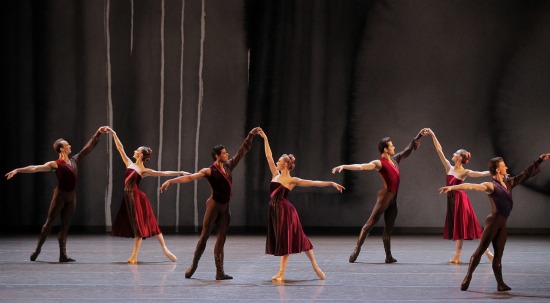
Tyler Angle, Maria Kowroski, Amar Ramasar, Sara Mearns, Robert Fairchild, Wendy Whelan and Daniel Ulbricht in Les Carillons. Photo: Paul Kolnik
It’s hard to believe that costume designer Mark Zappone and set designer Jean-Marc Puissant sat down together to share ideas, although it’s likely they did. The five principal women wear intricately cut dresses in shades ranging from red through cerise to lavender; a darker diagonal swath pleats down the bodice and flows into the skirt. The costumes may be overly tricky, but the silky fabric moves beautifully; turning, the dancers look like petunias in the wind. The color-keyed men have one arm bare. The costumes for the other cadre of 10 performers are similarly cut, but blue-green.
This shimmering ensemble dances in front of an enigmatic, painterly backdrop in grays, white, dark brown, and black. A dark vertical stripe like a fat tree trunk bisects it. On one side, near the floor are two curling shapes, and a splash of white paint hovers above them. The somberness, however, is often altered by Mary Louise Geiger’s lighting, which turns half the painting amber or otherwise tampers with its bleakness.
As I said, there’s a lot of unison, with groups of people rushing on to dance a bit, then rushing off (perhaps Wheeldon was aiming to make the whole stage peal like a big bell). As if to allude to the various gatherings in the Daudet play, Wheeldon often has dancers who are entering, or about to leave, pause a while to watch the goings-on. They also occasionally dance in a festive circle. In an intriguing moment near the beginning, they divide into two clusters and do slightly different, considerate things. The people in the group upstage right take turns laying one another down, until all are resting.
No wonder some of the blue-green folks hang around in darkening light to watch Sarah Mearns and Amar Ramasar embark on a duet. She begins, with his support, by standing on one pointe and slowly, luxuriously unfolding her other leg into the air, as if announcing her readiness for passion. And after their more abandoned dancing, that opening gesture concludes the affair. Two couples—Tiler Peck and Gonzalo Garcia, Ana Sophia Scheller and Daniel Ulbricht—sweep about in three-four time and take turns showing one another how happy and adroit they are.
One of the highlights of the ballet is a duet by Wendy Whelan and Robert Fairchild. It’s beautiful the way he reaches out toward the wings and pulls her slowly onto the stage, as if he’s both yearning to do so and afraid of what may happen. There is something out there beyond the light. Twice, he takes her to that side of the stage, lifting her so that her toes touch the floor and she’s half-slid along, yet at the same time she takes big strides. It’s a curious, strikingly ambivalent image—and also the last thing they do together before he walks away in the direction from which she entered. She’s left to wander among the sisterhood of blue-green women who have strolled in and begun to move in harmony.
Amid a bountiful spread of dancing that includes a duet for Maria Kowroski and Tyler Angle, Mearns performs a seductive solo with the generosity, daring, and understated fluidity that marks everything she does. The music for this passage has the aura of a tarantella or something darker, reminding us that Bizet was shortly to premiere his Carmen. Peck has a brighter, faster, twistier solo, which she dances wonderfully. And some welcome bits of counterpoint appear to break the unison passages. The music turns raucous toward the end, and Ramasar leaps around everyone onstage, as if to bind the whole community together for a few exhilarating seconds.
Wheeldon created Polyphonia for the NYCB in 2001, when he was still in his twenties. It remains one of his finest works. You can discern the nod to Balanchine. When four couples, lined up at the back, begin the ballet by shooting their limbs into spiky counterpoint, you think you’re seeing the opening of Agon doubled. When a man (in this case, Jared Angle) exits from a pas de deux by upending his partner (Whelan) behind him and side-stepping away with her legs sprouting above him like antlers, you think of Episodes.
But Wheeldon’s choreography has always revealed individual traits. György Ligeti’s piano music inspired him to maintain a balance between dissonance and classical harmony. The occasional gimmickiness that calls attention to itself crops up in Polyphonia, but so does a tender adventurousness in terms of pas de deux. In 2001, when I first wrote about the second of the two duets originally performed by Whelan and Jock Soto, I was struck by the way Wheeldon used awkwardness: “In the silences between Ligeti’s notes, Whelan slowly climbs up Soto and clamps herself to him. There’s something touchingly vulnerable about this ungainly move, and also something spidery, as if the two were sucking love from each other.”
In the middle of Polyphonia on the all-Wheeldon program, a terrible accident occurred. During a pas de deux with Gonzalo Garcia, Jennie Somogyi suddenly crumpled, legs turned in; then she straightened up and hobbled offstage. Garcia took a moment to assimilate what had happened and quickly followed her. Pianists Cameron Grant and Alan Moverman kept playing, and after an anxious few minutes, Mearns and Sterling Hyltin arrived to perform the ensuing trio as a duet. In the time it took for that duet, for Garcia and Adrian Danchig-Waring to perform their comradely number, and for Craig Hall and Mearns to dance wonderfully together, a semi-miraculous save occurred. Peck— who also dances the role Wheeldon made for Somogyi— was in her dressing room, preparing for the next ballet. She hauled on the appropriate purplish leotard, tied on her pointe shoes, tried a few moves backstage with Garcia (not her usual partner in Polyphonia), and appeared for the “Cantabile molto legato” quartet. Our heroine.
The tragedy is that Somogyi, who was seriously injured several years ago, had ruptured her Achilles tendon. Recovery is neither easy nor quick. Let there be a massive crossing of fingers.
Wheeldon made DVG: Dance à Grande Vitesse for Britain’s Royal Ballet in 2006. The title links it to the Michael Nyman score to which it’s set: MGV/ Musique à Grande Vitesse!. Nyman created the score to celebrate the 1993 opening of the French rail line known as the TGV (train à grande vitesse), conceiving the music as five separate, related journeys to different destinations.
Two things have always characterized Wheeldon’s work. One is the variety of his ideas for ballets (remember Carousel, based the Rodgers and Hammerstein musical, and his re-imagined Swan Lake for the Pennsylvania Ballet, etc.). The other is his penchant for ambitious design concepts (remember Scènes de Ballet, with its vision of a fin-de-siécle Russian ballet class, in which the stage was diagonally bisected by a two barres with an imaginary mirror between them).
Jean-Marc Puissant’s set for DVG could suggest a wrecked train made of giant-sized duct tape. The curling, lop-sided, silvery shapes are quite tall at one end, with a hint of windows, and they diminish across the stage until some are barely mounds. They could, at a stretch, suggest a vanishing perspective seen horizontally. Jennifer Tipton’s lighting (recreated by Jesse Belsky) includes an enormous lamp shining down on a diagonal from a high corner. A come-and-go corps of 15 is often behind the “train.” Initially, during a pas de deux in which Craig Hall helps Teresa Reichlen do uncanny things with her long limbs, members of the ensemble stand straight-kneed, feet apart, and rock stiffly side to side, some going one way, some the other. Later, behind a taller “car,” they jump up and down irregularly, waving deadpan goodbyes (or hellos). Another time, they interlace like wavering tracks.
Nyman’s pulsing, chugging, blaring music (conducted fervently by Clotilde Otranto) mixes saxophones with piano, strings, and percussion, which makes for some quiet moments amid the furor of travel. Wheeldon’s choreography, not surprisingly, evokes speed, wheels rolling along slick tracks, travel, and encounters along the way. The men cross the stage, rotating their partners above them, and there are additional patterns that suggest cranks and wheels. There’s a lot of going, whether by hordes or threes or couples. At one point, it’s hard to decide whether you’re seeing the Rape of the Sabine Women or guys hefting their luggage.
Wheeldon is expert at devising pas de deux that make the NYCB dancers look wonderful and smart. The duets for Reichlen and Hall, Peck and Andrew Veyette, Ashley Bouder and Joquin De Luz, Maria Kowroski and Tyler Angle vary in terms of mood and speed, and capitalize on the performers’ strengths, e.g. Kowroski’s height and flexibility and the length and wallop of her legs, De Luz and Bouder’s speed and springiness. The choreography’s connections with meetings on a journey or conjugal trips are like understated abstractions of a relationship’s dynamics.
The music and dancing build in speed and noise. At the climax, lights reveal three drummers in one of the theater’s boxes close to the stage, beating the tar out of their instruments. The momentum is terrific.
Wheeldon has a great deal to offer a company. He takes risks, occasionally stumbles, but knows how to make ballets that are both beautifully designed and meaningful. It would be nice if he’d settle down in a hospitable, creative climate and turn out vintage work. Could that be New York?

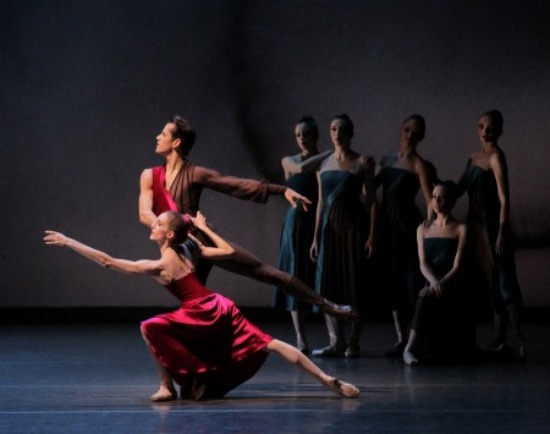
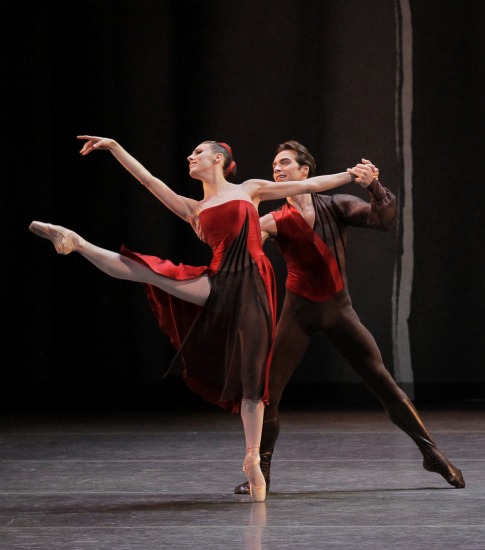
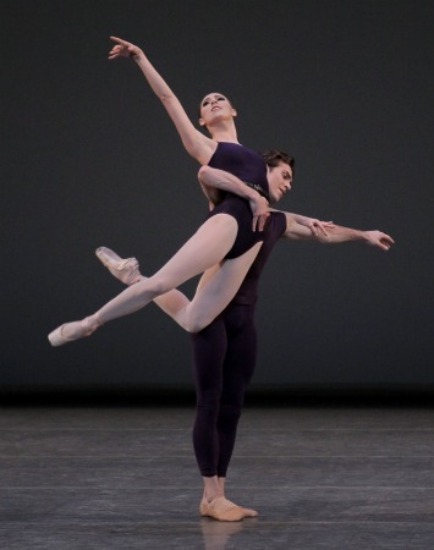
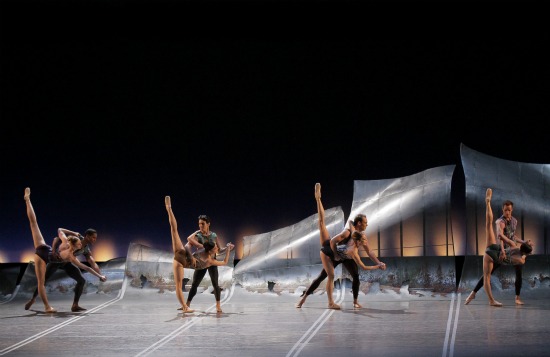
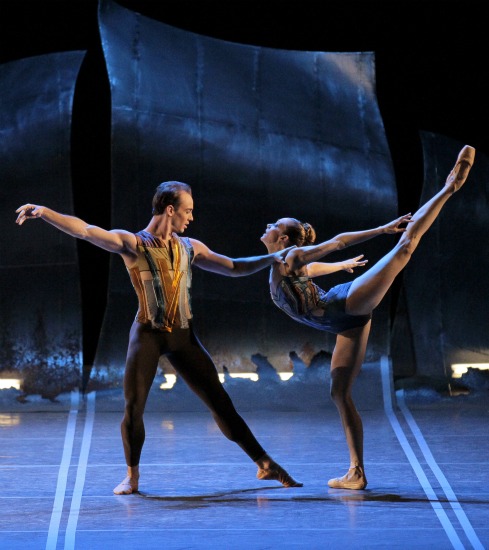
Seems unlikely he will settle in NYC again for hasn’t he been given some choreographic title (along w/MacGregor) that starts when Dame Mason leaves?